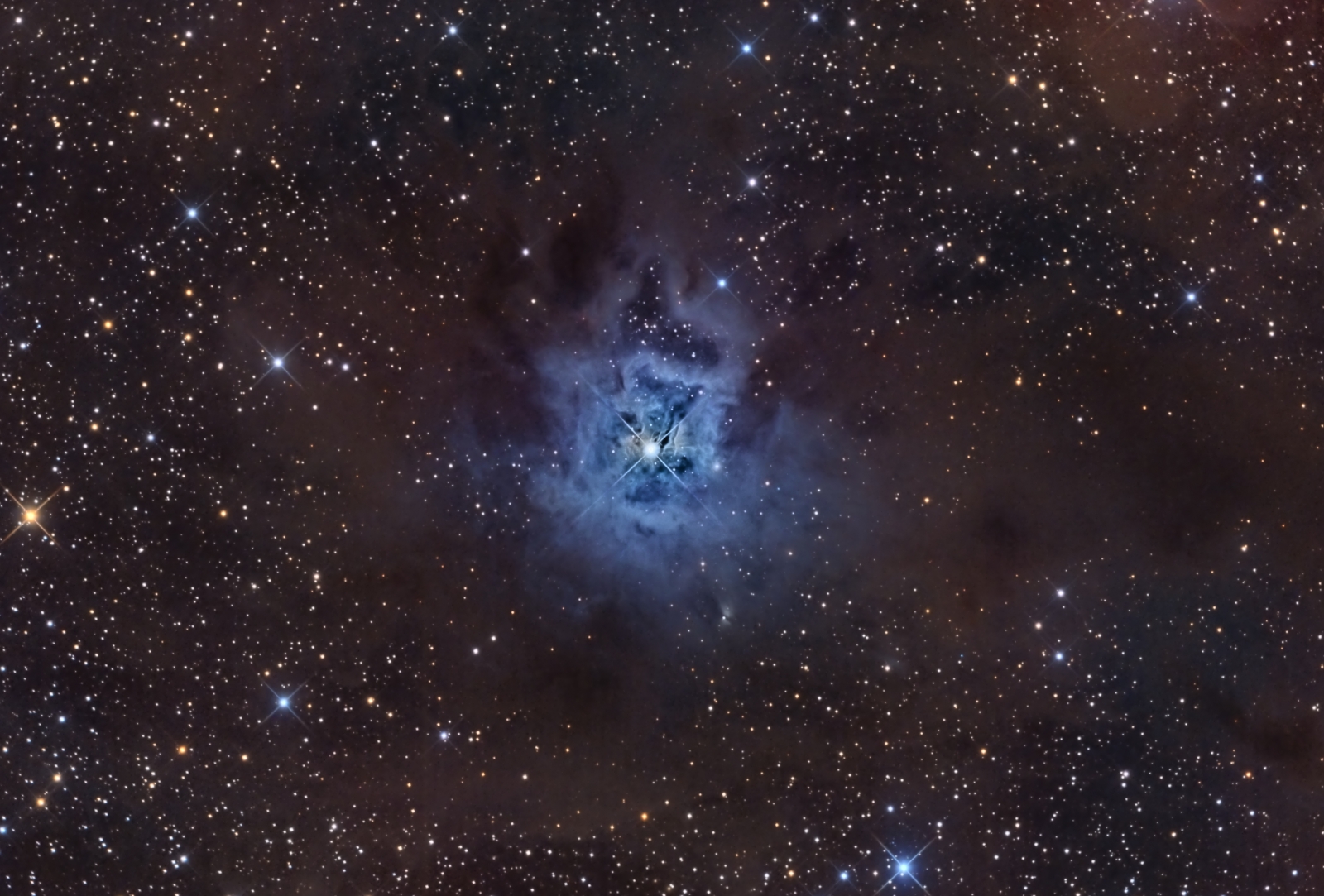NGC7023, The Iris Nebula
 Click image for full size version
Click image for full size version
September 10, 2016
This is the Iris Nebula, NGC7023. It is a reflection nebula, the blue coming from light reflected off soot/dust behind the bright star. There is lots of soot and dust visible throughout the image. This nebula is in our own Milky Way galaxy, and is relatively close at about 1,300 light years from Earth. The star at the centre of the nebula is easy in binoculars, but the nebula itself is very challenging to see visually. I imaged this object in 2013, but covered a relatively small field compared to this version, which does a better job at showing how dusty this region of space is.
Tekkies:
SBIG STL-11000M camera, Baader R, G and B filters, 10″ f/6.8 ASA astrograph, Paramount MX. Guided with SBIG’s external guide camera and 80 mm f/6.25 Lumicon achromatic refractor. Acquisition, guiding and mount control with TheSkyX. Focusing with FocusMax. Automation with CCDCommander. All preprocessing and post-processing in PixInsight. Shot from my SkyShed in Guelph, Ontario. Little to no moonlight, good to excellent transparency, and good to very good seeing throughout acquisition.
20 x 15m unbinned with each of R, G and B filters (total = 15 hr).
RGB
Creation and cleanup: R, G and B masters were cropped and processed separately with DBE. R, G and B were combined to make an RGB image which was processed with ColourCalibration.
Linear Noise Reduction: MultiscaleLinearTransform was used to reduce noise in the background areas. Layer settings for threshold and strength: Layer 1: 3.0, 0.5 Layer 2: 2.0, 0.35 Layer 3: 1.0, 0.2 Layer 4: 0.5, 0.1
Stretching: HistogramTransformation was applied to make a pleasing yet bright image. During stretching, it was noted that the colours were not properly balanced for the background, so this was adjusted manually using sliders for the individual colour channels, as well as the RGB/K slider.
Synthetic Luminance:
Creation and cleanup of SynthL: The cleaned up R,G and B masters were combined using the ImageIntegration tool (average, additive with scaling, noise evaluation, iterative K-sigma / biweight midvariance, no pixel rejection).
Deconvolution: A copy of the image was stretched to use as a deconvolution mask. A star mask was made from unstretched SynthL to use as a local deringing support. Deconvolution was applied (80 iterations, regularized Richardson-Lucy, external PSF made using DynamicPSF tool with about 20 stars; local deringing at 70% and global dark deringing at 0.03).
Linear Noise Reduction: MultiscaleLinearTransform was applied to reduce the noise. Layer settings for threshold and strength: Layer 1: 3.0, 0.5 Layer 2: 2.0, 0.35 Layer 3: 1.0, 0.2 Layer 4: 0.5, 0.1
Stretching: HistogramTransformation was applied to make a pleasing yet bright image.
Dynamic Range Compression: HDRMultiscaleTransform was applied at 6 and 4 pixel scales, using a mask to protect background, faint nebula and stars.
Nonlinear Noise Reduction: TGVDenoise was applied and the image was re-stretched to reset the black point.
Local Contrast Enhancement: LocalHistogramEqualization was run at scales of 50 and 150 pixels to restore contrast lost during dynamic range compression, again using a mask.
Combining SynthL with RGB:
The luminance channel of the RGB image was extracted, processed and then added back into the RGB image as follows:
1. Extract luminance from the RGB image.
2. Apply LinearFit using SynthL as the reference.
3. Use ChannelCombination in Lab mode to replace the RGB’s luminance with the fitted luminance from step 2.
4. LRGBCombine was then used to make a SynthLRGB image.
Final Processing of SynthLRGB:
MultiscaleLinearTransform was applied to sharpen the brightest parts of the nebula (bias +0.04 for layers 2 and 3), protecting other areas with a mask.
The DarkStructureEnhance script was applied with a strength of 0.07 to slightly darken dark areas in the nebula and dust. Background, stars and nebula brightness, contrast and saturation were adjusted in several iterations using Curves with masks as required. TGVDenoise was applied to the darkest parts of the image outside the nebula, using a highly selective mask. The mask was made by using PixelMath to subtract a star mask from a highly blurred range mask that selected just the darkest parts of the image (rescaling off).
Image scale is about 1.1 arcsec per pixel for this camera / telescope combination.






Thank you for your wonderful work it is awesome that you do this for all of us to see. Thankyou